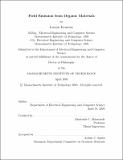| dc.contributor.advisor | Akintunde I. Akinwande. | en_US |
| dc.contributor.author | Kymissis, Ioannis, 1977- | en_US |
| dc.contributor.other | Massachusetts Institute of Technology. Dept. of Electrical Engineering and Computer Science. | en_US |
| dc.date.accessioned | 2005-05-19T15:23:50Z | |
| dc.date.available | 2005-05-19T15:23:50Z | |
| dc.date.copyright | 2003 | en_US |
| dc.date.issued | 2003 | en_US |
| dc.identifier.uri | http://hdl.handle.net/1721.1/16947 | |
| dc.description | Thesis (Ph. D.)--Massachusetts Institute of Technology, Dept. of Electrical Engineering and Computer Science, 2003. | en_US |
| dc.description | Includes bibliographical references (p. 207-218). | en_US |
| dc.description | This electronic version was submitted by the student author. The certified thesis is available in the Institute Archives and Special Collections. | en_US |
| dc.description.abstract | Field emission displays (FEDs) show great promise as high performance flat panel displays. The light emission process is efficient, long lifetimes are possible with high brightness, and bright passive matrix displays can be built. Because passive matrix displays don't need a transistor backplane, it was once thought that these displays would be cheaper to fabricate than their competitors. It is now clear that this is not the case. Fabricating a transistor backplane has turned out to be less expensive than micromachining an array of uniform field emitter tips with aligned gates. Competing technologies which use an active backplane (such as active matrix liquid crystal panels) have become ubiquitous, and FED technologies developed to date have been too expensive for the consumer market. This thesis presents a new strategy for creating a low-cost field emission display. This strategy begins by creating a field emitter out of organic conductors-a class of materials mostly neglected to date for this application. The organic emitter is made by copying a non-lithographic template. The process takes 5 minutes, occurs at room temperature and at atmospheric pressure, and does not damage the template. We show that organic conductors are easy to pattern into regular patterns and can form structures which exhibit field emission, with field enhancement factors of about 100-600 times. The field emission follows a Fowler-Nordheim characteristic. Also explored are some of the properties of organic conductors in vacuum such as conductivity over time, the interaction of the organic field emitter with background gases, and the conduction mechanism. In particular, we show that oxygen degrades the emission properties of organic field emission tips, and that organic materials retain sufficient conductivity in vacuum to serve as field emitters. | en_US |
| dc.description.abstract | (cont.) The second prong of the strategy is to combine the field emitter with an inexpensive transistor. A thin-film transistor made using an organic semiconductor is used to control the emission from the field emitter. We demonstrate a circuit architecture which allows the transistor to control the field emitter without creating a micromachined gate. This architecture uses only one high voltage supply for the panel to extract and accelerate electrons toward the phosphor screen. We show that the field emitter current can be controlled over a range of about 1000:1 using only 30V. This is verified through measurements of spot brightness on a phosphor screen. We then show that using the transistor has additional advantages. The current noise is reduced by a factor of 20, and DC current degradation is eliminated for oxygen partial pressures up to 1 x 10-6 torr. A new linearized analysis is presented which explains the DC current control and noise reduction, and also estimates the work function fluctuation on the emitter tip. The experimental results are examined in the context of this analytical framework. The work in this thesis shows (1) that a field emitter can be made from an organic conductor using a simple process (2) a field emission display can be controlled without making an array of micromachined gates and (3) using a transistor has a number of advantages in addition to controlling the field emitter ... | en_US |
| dc.description.statementofresponsibility | by Ioannis Kymissis. | en_US |
| dc.format.extent | 218 p. | en_US |
| dc.format.extent | 18992183 bytes | |
| dc.format.extent | 18991638 bytes | |
| dc.format.mimetype | application/pdf | |
| dc.format.mimetype | application/pdf | |
| dc.language.iso | eng | en_US |
| dc.publisher | Massachusetts Institute of Technology | en_US |
| dc.rights | M.I.T. theses are protected by copyright. They may be viewed from this source for any purpose, but reproduction or distribution in any format is prohibited without written permission. See provided URL for inquiries about permission. | en_US |
| dc.rights.uri | http://dspace.mit.edu/handle/1721.1/7582 | |
| dc.subject | Electrical Engineering and Computer Science. | en_US |
| dc.title | Field emission from organic materials | en_US |
| dc.type | Thesis | en_US |
| dc.description.degree | Ph.D. | en_US |
| dc.contributor.department | Massachusetts Institute of Technology. Department of Electrical Engineering and Computer Science | |
| dc.identifier.oclc | 53277645 | en_US |
